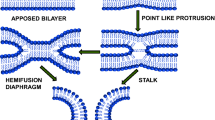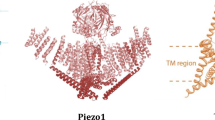Abstract
Structural pore models are generated for Vpu1–32WT from HIV-1 as well as for three mutants W23L, S24L and R31V. A computational methodology is employed which samples the whole conformational space of the pentameric assemblies of Vpu. The analysis of the related energy landscape reveals a small set of reasonable pore models, which are thoroughly investigated regarding their structural properties as well as their putative stability under native-like conditions. The models are also discussed in respect of earlier experimental findings about their channel activities. The study proposes functional pores reflecting the experimentally found conductance states of Vpu and its mutants.




Similar content being viewed by others
References
Chandrasekhar I, Kastenholz M, Lins RD, Oostenbrink C, Schuler LD, van Gunsteren WF (2003) A consistent potential energy parameter set for lipids: dipalmitoyl-phosphatidylcholine as a benchmark of the GROMOS96 45A3 force field. Eur Biophys J 32:67–77
Chen M-Y, Maldarelli F, Martin MA, Strebel K (1993) Human immunodeficiency virus type 1 Vpu protein induces degradation of CD4 in vitro: the cytoplasmic domain contributes to Vpu sensitivity. J Virol 67:3877–3884
Cohen EA, Terwilliger EF, Sodroski JG, Haseltine WA (1988) Identification of a protein encoded by the vpu gene of HIV-1. Nature 334:532–534. doi:10.1038/334532a0
Ewart GD, Sutherland T, Gage PW, Cox GB (1996) The Vpu protein of human immunodeficiency virus type 1 forms cation-selective ion channels. J Virol 70:7108–7115
Fischer WB (2003) Vpu from HIV-1 on an atomic scale: experiments and computer simulations. FEBS Lett 552:39–46. doi:10.1016/S0014-5793(03)00782-8
Fischer WB (2005) Viral membrane proteins: structure, function and drug design. In: Atassi MZ (ed) Protein reviews, vol 1. Kluwer Academic/Plenum, New York
Fischer WB, Krüger J (2009) Viral channel forming proteins. Int Rev Cell Mol Biol 275:35–63
Friborg J, Ladha A, Göttlinger H, Haseltine WA, Cohen EA (1995) Functional analysis of the phosphorylation sites on the human immunodeficiency virus type-1 Vpu protein. J Acquir Immune Defic Syndr Hum Retrovirol 8:10–22
Hsu K, Seharaseyon J, Dong P, Bour S, Marbán E (2004) Mutual functional destruction of HIV-1 Vpu and host TASK-1 channel. Mol Cell 14:259–267. doi:10.1016/S1097-2765(04)00183-2
Hub JS, de Groot BL (2008) Mechanism of selectivity in aquaporins and aquaglycoporins. Proc Natl Acad Sci USA 105:1198–1203. doi:10.1073/pnas.0707662104
Hussain A, Das SR, Tanwar C, Jameel S (2007) Oligomerization of the human immunodeficiency virus type I (HIV-1) Vpu protein––a genetic, biochemical and biophysical analysis. Virol J 4:1–11. doi:10.1186/1743-422X-4-81
Krüger J, Fischer WB (2008) Exploring the conformational space of Vpu from HIV-1: a versatile and adaptable protein. J Comput Chem 29:2416–2424. doi:10.1002/jcc.20986
Kukol A, Arkin IT (1999) Vpu transmembrane peptide structure obtained by site-specific fourier transform infrared dichroism and global molecular dynamics searching. Biophys J 77:1594–1601. doi:10.1016/S0006-3495(99)77007-4
Lindahl E, Hess B, Van der Spoel D (2001) GROMACS 3.0: a package for molecular simulation and trajectory analysis. J Mol Model 7:306–317
Ma C, Marassi FM, Jones DH, Straus SK, Bour S, Strebel K, Schubert U, Oblatt-Montal M, Montal M, Opella SJ (2002) Expression, purification, and activities of full-length and truncated versions of the integral membrane protein Vpu from HIV-1. Protein Sci 11:546–557. doi:10.1110/ps.37302
Margottin F, Benichou S, Durand H, Richard V, Liu LX, Benarous R (1996) Interaction between the cytoplasmic domains of HIV-1 Vpu and CD4: role of Vpu residues involved in CD4 interaction and in vitro CD4 degradation. Virology 223:381–386. doi:10.1006/viro.1996.0491
Mehnert T, Lam YH, Judge PJ, Routh A, Fischer D, Watts A, Fischer WB (2007) Towards a mechanism of function of the viral ion channel Vpu from HIV-1. J Biomol Struct Dyn 24:589–596
Mehnert T, Routh A, Judge PJ, Lam YH, Fischer D, Watts A, Fischer WB (2008) Biophysical characterisation of Vpu from HIV-1 suggests a channel-pore dualism. Proteins 70:1488–1497. doi:10.1002/prot.21642
Montal M (2003) Structure–function correlates of Vpu, a membrane protein of HIV-1. FEBS Lett 552:47–53. doi:10.1016/S0014-5793(03)00849-4
Neil SJD, Zang T, Bieniasz PD (2008) Tetherin inhibits retrovirus release and is antagonized by HIV-1 Vpu. Nature 451:425–431. doi:10.1038/nature06553
Nishimura K, Kim S, Zhang L, Cross TA (2002) The closed state of a H+ channel helical bundle combining precise orientational and distance restraints from solid state NMR. Biochemistry 41:13170–13177. doi:10.1021/bi0262799
Portella G, Hub JS, Vesper MD, De Groot BL (2008) Not only enthalpy: large entropy contribution to ion permeation barriers in single-file channels. Biophys J 95:2275–2282. doi:10.1529/biophysj.108.130609
Schubert U, Clouse KA, Strebel K (1995) Augmentation of virus secretion by the human immunodeficiency virus type 1 Vpu protein is cell type independent and occurs in cultured human primary macrophages and lymphocytes. J Virol 69:7699–7711
Schubert U, Bour S, Ferrer-Montiel AV, Montal M, Maldarelli F, Strebel K (1996a) The two biological activities of human immunodeficiency virus type 1 Vpu protein involve two separable structural domains. J Virol 70:809–819
Schubert U, Ferrer-Montiel AV, Oblatt-Montal M, Henklein P, Strebel K, Montal M (1996b) Identification of an ion channel activity of the Vpu transmembrane domain and its involvement in the regulation of virus release from HIV-1-infected cells. FEBS Lett 398:12–18. doi:10.1016/S0014-5793(96)01146-5
Schuler LD, Daura X, van Gunsteren WF (2001) An improved GROMOS96 force field for aliphatic hydrocarbons in the condensed phase. J Computational Chem 22:1205–1218
Sramala I, Lemaitre V, Faraldo-Gomez JD, Vincent S, Watts A, Fischer WB (2003) Molecular dynamics simulations on the first two helices of Vpu from HIV-1. Biophys J 84:3276–3284. doi:10.1016/S0006-3495(03)70052-6
Strebel K, Klimkait T, Martin MA (1988) Novel gene of HIV-1, vpu, and its 16-kilodalton product. Science 241:1221–1223. doi:10.1126/science.3261888
Unwin N (2005) Refined structure of the nicotinic acetylcholine receptor at 4 Å resolution. J Mol Biol 346:967–989. doi:10.1016/j.jmb.2004.12.031
van Damme N, Goff D, Katsura C, Jorgensen RL, Mitchell R, Johnson MC, Stephens EB, Guatelli J (2008) The interferon-induced protein BST-2 restricts HIV-1 release and is downregulated from the cell surface by the viral Vpu protein. Cell Host Microbe 3:1–8. doi:10.1016/j.chom.2007.12.002
van der Spoel D, Lindahl E, Hess B, Groenhof G, Mark AE, Berendsen HJC (2005) Gromacs: fast, flexible and free. J Comput Chem 26:1701–1718. doi:10.1002/jcc.20291
Wray V, Kinder R, Federau T, Henklein P, Bechinger B, Schubert U (1999) Solution structure and orientation of the transmembrane anchor domain of the HIV-1-encoded virus protein U by high resolution and solid-state NMR spectroscopy. Biochemistry 38:5272–5282. doi:10.1021/bi982755c
Acknowledgment
WBF acknowledges National Yang-Ming University and the government of Taiwan for financial support (Aim of Excellence Program), as well as the National Science Council of Taiwan (NSC). J.K. acknowledges a fellowship granted jointly by the Alexander von Humboldt-Foundation and NSC. We thank the Paderborn Center for Parallel Computing PC2 (http://wwwcs.uni-paderborn.de/pc2/) for providing computer time.
Author information
Authors and Affiliations
Corresponding author
Additional information
Viral membrane proteins, Heidelberg, December 2008.
Rights and permissions
About this article
Cite this article
Krüger, J., Fischer, W.B. Structural implications of mutations assessed by molecular dynamics: Vpu1–32 from HIV-1. Eur Biophys J 39, 1069–1077 (2010). https://doi.org/10.1007/s00249-009-0487-0
Received:
Revised:
Accepted:
Published:
Issue Date:
DOI: https://doi.org/10.1007/s00249-009-0487-0




